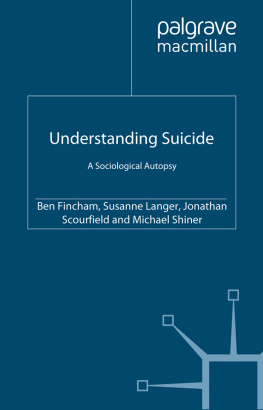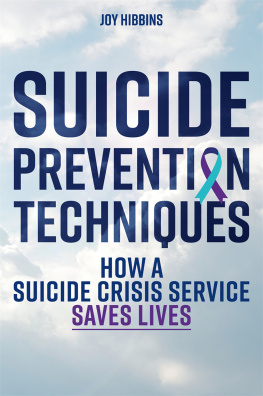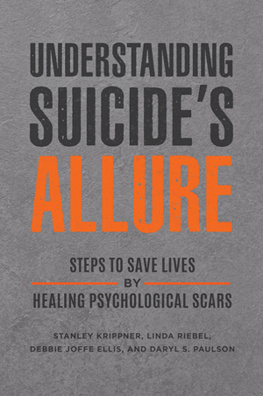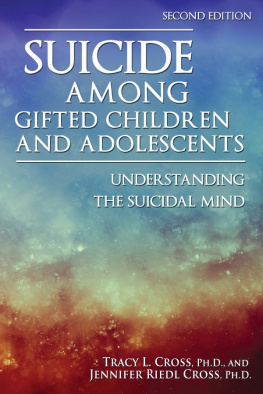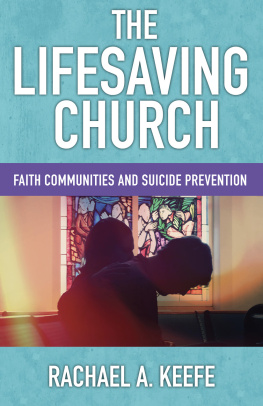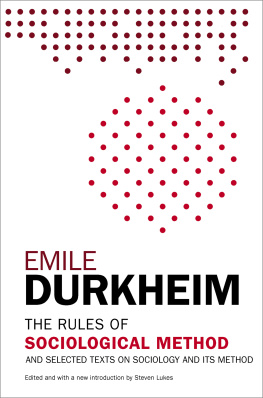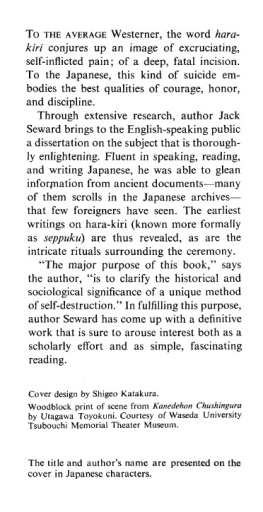References
Adam, K.S. (1973) Childhood, parental loss, suicidal ideation and suicidal behavior, in Anthony, E.J. and Koupernik, C. (eds) The Child in His Family: The Impact of Disease and Death. New York: Wiley.
Agerbo, E., Stack, S. and Petersen, L. (2009) Social integration and suicide trends in Denmark, 19062006. Paper delivered to the annual conference of the American Association of Suicidology, San Francisco, CA., April.
Aggarwal, N. (2008) Editorial: Farmer suicides in India: The role of psychiatry and anthropology. International Journal of Social Psychiatry, 54: 2913.
Ainsworth, M.D.S. (1967) Infancy in Uganda: Infant Care and the Growth of Love. Baltimore: John Hopkins University Press.
Ainsworth, M.D.S. (1991) Attachment and other affectional bonds across the life cycle, in Parkes, C.M., Stevenson-Hinde, J. and Marris, P. (eds) Attachment Across the Life Cycle. New York: Routledge.
Ainsworth, M.D.S., Blehar, M.C., Waters, E. and Wall, S. (1978) Patterns of Attachment: A Psychological Study of the Strange Situation. Hillside, NJ: Elbraum.
Allen, R. (2005) Statistics on deaths reported to coroners 2004. Home Office Statistical Bulletin 2005. London: Department of Constitutional Affairs.
Anderson, M. and Jenkins, R. (2006) The national suicide prevention strategy for England: The reality of a national strategy for the nursing profession. Journal of Psychiatric and Mental Health Nursing, 13(6): 64150.
Atkinson, J.M. (1978) Discovering Suicide: Studies in the Social Organization of Sudden Death. Pittsburgh, PA: University of Pittsburgh Press.
Barraclough, B. and Harris, C. (2002). Suicide preceded by murder: The epidemiology of homicide-suicide in England and Wales, 198892. Psychological Medicine, 32: 57784.
Bartholomew, K. (1990) Avoidance of intimacy: An attachment perspective. Journal of Social and Personal Relationships, 7: 14778.
Baudelot, C. and Establet, R. (2008) Suicide: The Hidden Side of Modernity. Polity: Cambridge, MA.
Beck, U. and Beck-Gernsheim, E. (1995) The Normal Chaos of Love. Cambridge: Polity.
Bell, C. and Newby, H. (1977) Doing Sociological Research. London: Allen and Unwin.
Bell, C. and Roberts, H. (1984) Social Researching. London: Routledge and Kegan Paul.
Berg, M. and Bowker, G. (1997) The multiple bodies of the medical record: Towards a sociology of an artifact. Sociological Quarterly, 38: 51325.
Berger, P. ([1967] 1990) The Sacred Canopy: Elements of a Sociological Theory of Religion. New York: Anchor Books.
Berkman, L.F., Glass, T., Brissette, I. and Seeman, T.E. (2000) From social integration to health: Durkheim in the new millennium. Social Science and Medicine, 51(6): 84357.
Bhaskar, R. ([1979] 1998) The Possibility of Naturalism: A Philosophical Critique of the Contemporary Human Sciences. London: Routledge.
Biddle, L. (2003) Public hazards or private tragedies? An exploratory study of the effect of coroners procedures on those bereaved by suicide. Social Science and Medicine, 56: 103345.
Biddle, L., Brock, A., Brookes, S.T. and Gunnell, D. (2008) Suicide rates in young men in England and Wales in the 21st century: Time trend study. British Medical Journal, 336: 53942.
Black, S.T. (1993) Comparing genuine and simulated notes: A new perspective. Journal of Consulting and Clinical Psychology, 4: 699702.
Blanchflower, D.G. and Oswald, A.J. (2008) Is well-being U-shaped over the life cycle?. Social Science and Medicine, 66: 173349.
Bloch, M. and Parry, J.P. (1982) Death and the Regeneration of Life. Cambridge: Cambridge University Press.
Blondel, C. (1933) Le Suicide. Strassbourg: Librarie Universitaire dAlsace.
Blumer, H. (1956) Sociological analysis and the variable. American Sociological Review, 21: 68390.
Blumer, H. (1969) Symbolic Interactionism: Perspectives and Method. Englewood Cliffs: Prentice Hall.
Bocock, R. (2002) Sigmund Freud. London: Routledge.
Booth, N. and Owens, C. (2000) Silent suicide: Suicide among people not in contact with mental health services. International Review of Psychiatry, 12: 2730.
Bostik, B.E. and Everall, R.D. (2007) Healing from suicide: Adolescent perceptions of attachment relationships. British Journal of Guidance and Counselling, 35(1): 7996.
Botsis, A.J., Soldatos, C.R. and Costas, S.N. (eds) (1997) Suicide: Biopsycho-social Approaches. Amsterdam: Elsevier.
Bourdieu, P. (1980) Questions de Sociologie. Paris: Editions de Minuit.
Bourdieu, P. (2001) Masculine Domination. Cambridge: Polity.
Bourdieu, P. and de Saint Martin, M. (1982) La Sainte Famille. Lepiscopat Francais dans le Champ du Puvoir. Actes de la Recherch en Sciences Socials, 44/55: 253.
Bourdieu, P. and Wacquant, L.J.D. (1992) An Invitation to Reflexive Sociology. Cambridge/Oxford: Polity Press.
Bowlby, J. (1969/1982) Attachment and Loss, Volume 1: Attachment. London: Hogarth Press.
Bowlby, J. (1973) Attachment and Loss, Volume 2: Separation: Anxiety and Anger. London: Hogarth Press.
Bradbury, M. (1996) Representations of good and bad deaths among death-workers and the bereaved, in Howarth, G. and Jupp, P.C. (eds) Contemporary Issues in the Sociology of Death, Dying and Disposal. Basingstoke: Macmillan.
Brandon, M., Bailey, S., Belderson, P., Gardner, R., Sidebotham, P., Dodsworth, J., Warren, J. and Black, J. (2009) Understanding Serious Case Reviews and Their Impact: A Biennial Analysis of Serious Case Reviews 20057, Research report DCSF-RR129. London: DCFS.
Breault, K.D. (1994) Was Durkheim right? A critical survey of the empirical literature on le suicide, in Lester, D. (ed.) Emile Durkheim, Le Suicide: 100 Years Later. Philadelphia: The Charles Press.
Bryman, A. (1988) Quantity and Quality in Social Research. London: Routledge.
Bryman, A. (2004) Social Research Methods. Oxford: Oxford University Press.
Burawoy, M. (2005) 2004 Presidential address: For public sociology. American Sociological Review, 70(1): 428.
Canetto, S.S. (1995) Men who survive a suicidal act: Successful coping or failed masculinity?, in Sabo, D. and Gordon, D. (eds) Mens Health and Illness: Gender, Power, and the Body, pp. 292304. Newbury Park, CA: Sage.
Canetto, S.S. (19923) She died for love and he for glory: Gender myths of suicidal behavior. Omega: The Journal of Death and Dying, 26(1): 117.
Canetto, S.S. (1997) Gender and suicidal behavior: Theories and evidence, in Maris, R.W., Silverman, M.M. and Canetto, S.S. (eds) Review of Suicidology, pp. 13867. New York: Guilford.
Canetto, S.S. and Lester, D. (2002) Love and achievement motives in womens and mens suicide notes. Journal of Psychology, 136: 5736.
Cantor, C. (2000) Suicide in the western world, in Hawton, K. and van Heeringen, K. (eds) The International Handbook of Suicide and Attempted Suicide, pp. 928. London: Wiley.
Carmin, J. and Balser, D. (2002) Selecting repertoires of action in social movement organizations. Organization and Environment, 15(4): 36588.
Cassidy, J. and Shaver, P.R. (2008) Handbook of Attachment: Theory, Research and Clinical Applications. New York: The Guilford Press.
Cattell, H. (2000) Suicide in the elderly. Advances in Psychiatric Treatment, 6: 1028.
Cavan, R.S. (1965 [1928]) Suicide. New York: Russell and Russell.
Cavanagh, J.T., Carson, A.J., Sharpe, M. and Lawrie, S.M. (2003) Psychological autopsy studies of suicide: A systematic review.

